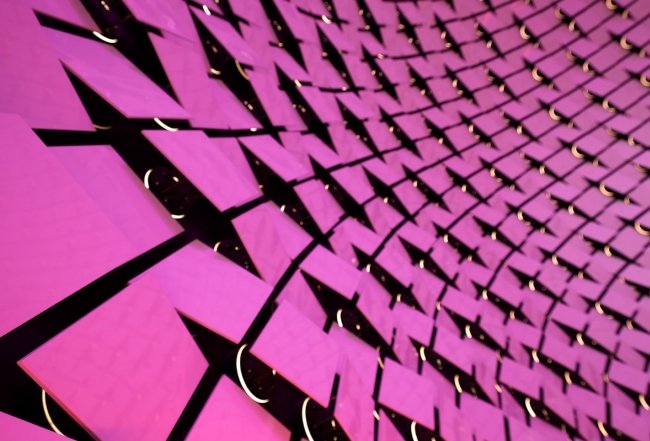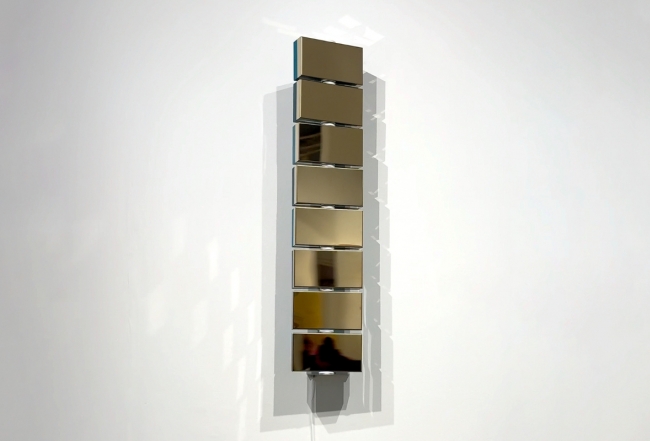Breakfast: Driving the Cutting Edge in Kinetic Art
When computer driven kinetic art studio Breakfast launched in 2009, the digital world was still in its infancy. Twitter was still developing from humble origins as a text messaging app while social media largely concerned itself with reuniting old school friends who had lost touch.

The art world, however, was about to see something completely new as Breakfast became a pioneering new force dedicated to in-person experiential art through entirely kinetic mediums.
A marriage of storytelling and the web
This dynamic combination of deep concepts telling important stories through software and hardware innovation - informed by real-time data via the web - also interacts with the audience and is light years away from traditional art.
Take, for example, Oceans which was commissioned for the second outpost of the Fontainebleau Hotel in Las Vegas. Made from Carrera marble and brass tinted stainless steel, it emulates the ocean’s surface as it retrieves new tide data from coastal cities around the world while the interactive element allows you to simulate moving your hand through the water’s surface.
“They shared with us the aesthetics and history of the original Fontainebleau in Miami, which is Art Deco, and this piece was inspired by how we could bring the ocean to the desert,” explains Breakfast founder Zolty, who is based near the studio in Brooklyn’s Dumbo district.
It’s just one of around 250 thought-provoking kinetic artworks created over the last 15 years which are displayed in galleries, private homes – and even an ocean cruiser - around the globe.
Breakfast beginnings
Occupying 10,000 square feet of factory-esque space looking out across the Brooklyn skyline, Breakfast is the culmination of Zolty’s lifelong obsession with all things mechanical and electrical.
“When I was a kid, I was always rewiring my toys, and eventually rewired my parents’ house and their cars too,” he recalls with a laugh. “I loved drawing, art and technology and in college, I pretty much designed my own major. It was the early 2000s, just when the web was starting to get interesting. I was addicted to the early flash animation websites and spent a few years working on crazy artistic screen stuff and coding.”
He met Breakfast co-founder Mattias Gunneras while working for a digital creative studio in London’s Shoreditch in 2008 and before long, the pair teamed up. “I was missing the twisting wires part of my life so I got back into learning basic electronics and created something called Baker Tweet.
“It was a little box we put in the Albion Bakery across the street from us. When the croissants came out, they would turn a dial, press a button and tweet it out. It became an early viral hit, ending up in MoMA and landing Mattias and I on a weird ride! We knew we had something and we started Breakfast off the back of it.”
From brand collaborations to fine art
Early mould-breaking prototypes and interactive experiments led to big-money commissions from brands like Forever 21, which in turn funded forays into experimental art. Zolty conceived and designed each concept while Mattias oversaw its construction.
“The early stuff was fun but what we were doing was so far ahead of the game at that time,” he remembers. “We decided to go fully into fine art about five years ago although we’re aware that our pieces appeal in commercial settings. It’s been crazy since then – we’ve had a lot of good luck.”
Breakfast’s team of 17 full-time software developers, producers, electrical and mechanical engineers was recruited from SpaceX, Disney, Rolls-Royce and NASA to ensure that each artwork is highly durable and sustainable.
“It was very important to me that that we didn’t sell artworks which break. We have 250 pieces out in the world, and it’s not good for business if they go wrong. We design and build every circuit board, motor and piece of metal entirely from scratch, the way NASA or SpaceX would do it, meaning that our mediums of Flip-Disc (physical discs which flip at 30FPS) and Brixels (modular blocks that can be combined to create moving walls) are very robust.”
In real terms, this means that while Breakfast’s innovative designs are much aped by copycats, they are never bettered.
A more recent brand collaboration with Tiffany & Co resulted in Sustainable Locks, based around the story of the company’s ethical sourcing of jewels and materials to create an iconic new bracelet.
“We wanted to do something really beautiful which felt like Tiffany but was far from straight up promotional marketing,” he says. “I always look for something that is meaningful in the brand, the untold story. They are sourcing jewels in more sustainable ways and this piece uses that so that the more people use the word sustainable online, the more this piece moves.”
A Willy Wonka wonderland
In simple terms, this highly collaborative collective delivers art people want to see more of. It’s a beautifully positive way of marrying the natural world - wind, the ocean and coastal weather patterns - with the web. And it all happens in an environment Zolty describes as “a Willy Wonka factory,” which passers-by are welcome to enter.
“We have a gallery upfront and anyone can come in. When pieces are being tested and nearing completion, they go into our gallery, an exhibition space with five to eight pieces at any time. We get very used to the works being in process but once the moment comes where they’ve been finished and installed, it’s a real wake up, what have we done moment!”
Working mainly on a commission basis, their largest artwork to date is multi-million dollar The Pearl, the world’s largest kinetic sculpture and the culmination of over four years work. At 13.7m high and 16m in diameter, this stunning installation features an enclosed staircase leading to an upper deck on a Royal Caribbean cruise ship.
Inspired by the sea and crafted using nearly 3,000 computer-controlled sway tiles, each tile is equipped with three custom actuators, enabling outward and tilt movements along 18-inch linear rails supported by 9,000 brushless motors. With movement informed by local tidal and wind data in the Caribbean, it seamlessly mimics the motion of water, wind and marine life.
At the other end of the scale, Gusts is a limited edition of Brixels pieces moving in response to the current wind patterns in any city the collector chooses, while smaller Flip-Disc works, which are also limited to eight editions, are popular with art collectors and typically start at around US $30,000.
“The big pieces get the most attention but by far, the majority of pieces that we sell are going into private homes. Several celebrities and major collectors have our pieces, and I’ve had some very interesting Zooms!”
Making art more accessible
Breakfast’s work elicits emotional and superlative responses from their 84k Instagram followers and Zolty is keen to develop new, more affordable mediums with the potential to reach beyond the hallowed and moneyed traditional collectors.
“Yes, our creations cost more than I wish,” he admits. “The prices are expensive but it’s relative, and in reality, they probably aren’t high enough. I’m working on a new medium which will allow us to create a Breakfast piece which costs less. Most our pieces have hundreds of thousands of moving parts but I hope this flexible new medium will bring the price to a more affordable level yet still appeal to the elegance higher end art collectors want.”
Selling direct as well as through London’s Disruptive and HOFA galleries and Miami’s Wynwood, chances are if you contact Breakfast, Zolty will chat through your idea with you to come up with the perfect piece. Next, he is moving outdoors to create sculptures which can withstand the elements. “I want us to build a modern day Eiffel Tower, something so iconic it represents a city. It’s my goal now.”
In the meantime, he is off to Venice for the Biennale, where a Flip-Disc piece dubbed Interwoven Existence is part of the No Man is an Island series which I’m lucky enough to get an exclusive preview of. It records interactions with each individual who looks at it before replaying them in small sections alongside every other recording made that week, thereby making you part of a bigger community.
“When I started Breakfast, people were getting rid of their stereos because everything was going into the screen,” he recalls. “I saw an opportunity to put tactile things back into the world.
“Every year that passes, people are appreciating this more and more as everything becomes more screen-based. The art world is desperate for the next new thing and in kinetic art, we are walking a line where physical artwork can be dynamic and resonate with those looking for something new and different.”
Read Next
Arius: Meet the Company Transforming the Art World
How Bannenberg & Rowell are Upholding the Legacy of ‘Godfather’ of Modern Yacht Design
MB&F Founder Maximilian Büsser on Pushing the Limits of Horology














